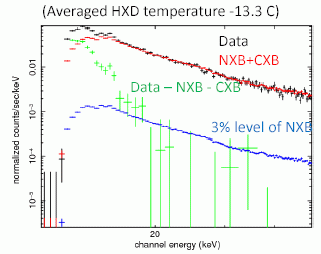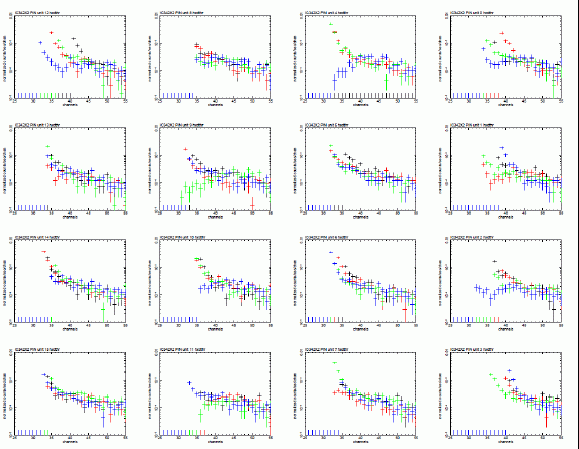HXD-PIN Noise
2012-04-03

Fig 1: Example of the PIN spectrum with the noise contamination.
The noise contamination is identified when you look at the individual 64 PIN spectrum. The noise level is different among PINs, unlike the cosmic signals and background signals. In the XSELECT, the following command selects the events of individual PIN.
filter column "UNITID=2:2 PIN_ID=3:3"
This is the example to extract the event of PIN NO.3 of the Well UNIT 2. UNITID is in the range of 0...15 and PIN_ID is in the range of 0..3.
Figure 2 is an example of individual 64 PIN spectra for the data with the noise contamination.

Fig 2: Emample of 64 individual PIN spectra with noise conamination.
The following are an example of the C-shell script for creating the 64 PIN spectrum and plotting them in the postscript files with XSPEC. This is just an example, so not necessarily supported for general cases.
#!/bin/csh
#
set ifile = pin_cl.evt.gz
echo $ifile
set unitid = 0
while ($unitid < 16)
set pinid = 0
while ($pinid < 4)
echo unitid=$unitid, pinid=$pinid
## extract PIN spectrum of individual PIN
xselect <<EOF
xsel
read events
.
${ifile}
filter column "UNITID=${unitid}:${unitid} PIN_ID=${pinid}:${pinid}"
extract events
extract spec
save spec
pin_u${unitid}p${pinid}
exit
no
EOF
@ pinid ++
end
@ unitid ++
end
#
# plot spectra
#
set unit = 0
while ($unit < 16)
xspec <<EOF
data 1:1 pin_u${unit}p0.pha
data 2:2 pin_u${unit}p1.pha
data 3:3 pin_u${unit}p2.pha
data 4:4 pin_u${unit}p3.pha
cpd /xw
plot ld
iplot
ra x 25 55
ra y 0.00001 0.01
lw 7
cs 1.3
la ti
la fo PIN unit ${unit}
time off
plot
hard pin_u${unit}.ps/cps
q
exit
EOF
echo $unit
@ unit ++
end
If you have any questions concerning Suzaku, visit the Feedback form.

